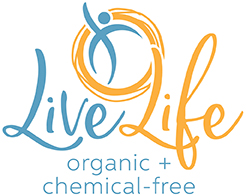
Do you dread the alarm clock going off because you wake up exhausted and with brain fog each day?
Your bedroom may have toxic furniture that’s putting chemicals into the air you breathe all night long.
If you change this, you could wake up more energized and thinking clearly each morning rather than feeling crappy.
We’ll walk you through how to get rid of the toxic furniture and choose non-toxic dressers, nightstands, and more! Plus, give you some ideas for where to buy them.
Why Would My Bedroom Have Toxic Furniture?
Unknowingly, we buy furniture that is made of lots of glues, adhesives, plastics, resins, and wood dust or particles. These woods are called composite woods. On furniture descriptions, you’ll see them described as:
- MDF
- Engineered Wood
- Plywood
- Veneer wood
- Particle board
- Hardboard
- Melamine (a type of particle board)
- “Hardwood” (except it’s only partly hardwood – not solid hardwood)
Manufactures sometimes call these woods “environmentally friendly,” “green,” or “eco-friendly,” but the truth is they are not. Since there is no measurement of what environmentally friendly, green, or eco-friendly means, anyone can put this label on any product.
Why Are Composite Woods Toxic?
By their very nature, composite woods (all types) must have a glue, adhesive, plastic or resin in them to become a composite wood. These glues, adhesives, plastics and resins often contain volatile organic compounds (VOCs) and a host of other chemicals that can be toxic to our health.
Why Would Finishes Be Toxic?
Stains, top coats, and paints used on furniture are often made of VOCs, too. In addition, they have chemicals that are on the U.S. Environmental Protection’s list of Hazardous Air Pollutants (plus other harmful chemicals). Some of these chemicals off-gas into the air, some do not but can still be harmful to our health.
How Do These Chemicals Get into Our Bodies?
Chemicals get into our bodies in three ways: breathing them in, touching them, eating or swallowing them.
Read more about it: 3 Ways Our Bodies Fill With Chemicals
Related to furniture, both the type of wood and type of finish can put chemicals into the air we breathe by off-gassing.
Plus, if our clothes sit on or in these products – such as dressers and night stands – our clothes absorb the chemicals too. When we wear our clothes, we’re breathing in the chemicals from the furniture as well.
How Could This Affect my Health?
Volatile organic compounds (VOC), and other toxic chemicals found in our bedrooms cause endocrine disruption, which affects the quality of sleep that we get.
There are no safe amounts of toxic, endocrine disrupting chemicals, according to the Endocrine Society.
Since our bodies need good sleep to clear toxins from the brain, repair our cells, and give us clear thinking, it’s important that we (along with our kids) sleep in a nontoxic bedroom.
It allows our bodies to wake up feeling energized and clear!
How to Wake Up Energized and Thinking Clearly
Switch out your old dresser and night stand for a nontoxic dresser or nightstand. Why?
The most effective way to have good air in your room is to choose furniture (and other products) that don’t have chemicals in them in the first place.
It’s really that simple.
What to Look for in Non-toxic Furniture
In the furniture description, look for these three things:
- The words “solid hardwood” – and make sure the dresser drawer boxes and backs are solid hardwood, too. A few of the common hardwood names include ash, oak, maple, cherry, poplar and walnut.
- Non-toxic glues (plus nails or screws usually) to hold the furniture together.
- Stains and finishes, or paints, that have zero-VOCs and are free of Hazardous Air Pollutants (HAPs).
Next Steps
Having a nontoxic dresser and healthy bedroom overall can make a big impact on the quality of your sleep and overall health. Pick one piece of furniture to buy non-toxic and get it! It’s a simple and fun step in creating your organic, chemical-free home.
Want more simple ways to transform your house into a healthy home?
Final Thoughts
THANK YOU! For taking charge of your health. For being part of the local and global change, transforming our houses into healthy homes!
You’re amazing. Keep going! One step at a time.
-Angie
